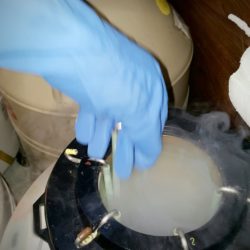Cryopreservation
Cryopreservation overview
- Cryopreservation is the systematic freezing and storage of eggs, sperm or embryos, allowing the preserved cells to be used at a later time.
- Individuals or couples may choose cryopreservation to preserve fertility during cancer treatments or delay a pregnancy attempt until some time in the future.
What is cryopreservation?

Cryopreservation is the process of freezing eggs, sperm or embryos to sub-zero temperatures for later use. When the eggs, sperm or embryos are needed, they are thawed and fertilized or used in a fertility treatment cycle. Sperm may be used for intrauterine insemination (IUI) or in vitro fertilization (IVF) procedures. Eggs and embryos will be used during in procedures associated with IVF.
Cryopreservation provides indefinite longevity for the cells being frozen. At the time of freezing, all biological activity is suspended until the cells are thawed.
Cryopreservation typically uses liquid nitrogen to freeze the eggs, sperm or embryos to -320 degrees Fahrenheit. The lab uses cryoprotective agents to prevent damage to the cells during the process. It is unknown how long reproductive cells may be frozen and stored for future use, but cryopreservation is considered to be indefinite.
Egg freezing
If a woman decides to freeze her eggs, she must take medications daily for a number of days to stimulate her ovaries to produce many more eggs than normal. This is the same preparation used for an egg retrieval in IVF. Once the eggs are thought to be mature, they are removed from the ovarian follicles and frozen by embryologists in the laboratory. Embryologists most often use vitrification to prepare the oocytes for storage. The oocytes may be stored at the fertility clinic in liquid nitrogen storage tanks or at a commercial cryopreservation bank until needed by the woman or couple for IVF treatments.
Sperm freezing
If a man decides to preserve his sperm, he can provide a sample for cryopreservation. However, if no sperm are present in the semen or he cannot ejaculate, a surgical sperm extraction may be used to remove sperm directly from the testicle. The sperm sample is then frozen and stored at a fertility clinic or sperm bank until ready to be used for intrauterine insemination (IUI) or IVF.
Embryo freezing
To preserve embryos, eggs are collected as described above. In the IVF process, once the eggs are collected, they are fertilized with the partner’s sperm in a lab. The resulting embryos are cultured for a few days, allowing the cell division process to reach optimal conditions before the embryos are frozen and stored at a fertility clinic or cryopreservation bank until they are to be transferred into the female’s uterus at a later date.

Security is our top priority
LLU Center for Fertility’s lab equipment, incubators and cryotanks are monitored 24 hours a day by XiltriX. This advanced monitoring and data system allows our team to recognize any abnormalities in laboratory conditions in real time, helping us prevent changes that could affect the health of sperm, eggs and embryos.
Who should use cryopreservation?
People may choose cryopreservation for a variety of reasons, the most urgent being impending cancer treatments. Chemotherapy and radiation can damage a person’s fertility or cause infertility while killing the deadly cancer cells.
Other reasons to preserve fertility can involve lifestyle, social or career choices. Many individuals involved in careers that are life or fertility threatening choose to freeze eggs, sperm or embryos. Young women can freeze their eggs to ensure fertility and optimum egg age if and when they decide to start a family later in life through IVF.
Risks of cryopreservation
Freezing eggs, sperm and embryos is a routine and safe process. While it seems counter intuitive, transferring warmed (thawed) embryos is actually associated with improved pregnancy outcomes compared to a fresh cycle transfer, in which embryos are not frozen. However, there is always the possibility that not all of the cells will survive the freeze –thaw process. Overall, the survival rate is quite high, however, multiple cycle may be needed to ensure a pregnancy in the future. Pregnancy rates using warmed embryos are very similar to those with fresh embryos.
Benefits of cryopreservation
The primary benefit is insuring a person’s fertility even if he or she will be undergoing harmful cancer treatments, working in a dangerous career, or do not plan to have children for some time. Although future pregnancy cannot be guaranteed, cryopreservation allows for peace of mind about a future family.
The cost of keeping eggs, sperm or embryos preserved will vary from $400 on the low side to $1,200 per year. It’s a good idea to shop around for freezing and storage fees because most insurance companies do not cover freezing or storage costs.
